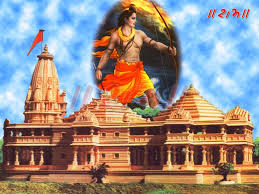| RAM MANDHIR IN AYODHYA Prime Minister Narendra Modi performed ‘bhoomi pujan’ at Ayodhya, formally launching the construction of Ram Temple. Terming it a ‘historic moment’, the Prime Minister said, the temple will serve as a ‘’modern symbol of Indian culture and with it the country was creating a golden chapter for itself’’. ”This temple will inspire the coming generations about faith, reverence and resolve, and would not only augment the grandeur of Ayodhya but also change the economy of the entire region.’’ ”This day is testimony to the truth of the crores of Ram bhakts. This day is an incomparable gift of truth, non violence, faith and sacrifice to peace loving India”, Prime Minister said during his visit offering prayers at the Hanumangarhi Temple and offered aarti before the idol of Ram Lalla at the Ram Janmabhoomi. He planted a ‘parijat’ tree at the site of the Temple and released a postage stamp commemorating the historic moment. The dispute had been in history for centuries and it was in 1885, Mahant Raghubir Das filed a petition in the Faizabad District Court seeking permission to build temple outside the disputed structure. However the Court rejected the request. Ram Lalla idol was seen placed under the central dome outside the disputed structure in 1949 and Gopal Singh Visharad filed a suit in the District Court for worship. In 1959, Nirmohi Akhara filed a suit for possession of the site. In 1961, Uttar Pradesh Sunni Central Waqf Board also filed a suit for possession of the site. In 1985, The Court ordered the site to be opened for worship to Hindu devotees. After the demolition of Babri Masjid on 6 December 1992, the Central Government passed the ‘Acquisition of certain areas at Ayodhya Act’ in 1993. In 2010, The Allahabad High Court pronounced judgment on the disputed site. In 2011 the Supreme Court stayed the High Court verdict of dividing the land between Sunni Waqf Board, Nirmohi Akhara and Ram Lalla. The Court constituted a three judge Bench to hear pleas challenging Allahabad High Court verdict. On January 8, 2019, the Supreme Court constituted a five judge Constitution Bench, headed by Chief Justice Ranjan Gogoi to hear the cases. Later, the Court favoured mediation and appointed mediators to settle the dispute. As the mediation failed, the Supreme Court decided to conduct day to day hearings from August 6, 2019. On 9 November 2019, the Supreme Court pronounced the historic judgement that the entire 2.77 acres of disputed land was granted to deity Ram Lalla. The Supreme Court also directed the Central Government and Uttar Pradesh Government to allot 5 acres of land to build a mosque in Ayodhya. The historic, unanimous judgement of the Supreme Court settled all legal disputes of centuries in this country. |


